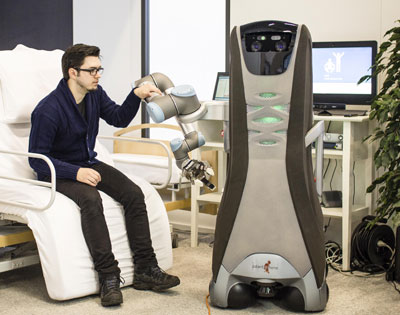
First Care-O-bot in Denmark: Rolling Service Robot Can Fetch Water and Clean
Scientists are working to develop the Care-O-Bot, making it the world’s most advanced service robot that can aid elderly people in daily life – pick up objects and clean. The plan is that in ten years’ time, the robot will roll into the first care home.
On four wheels, the approximately one meter tall robot comes rolling. She is one of the world’s most advanced service robots and so far the only of her kind in Denmark.
- It definitely has a wow-effect, says team leader Lars Dalgaard from the Department of Technology and Innovation, Robot Systems Engineering. For three months he has cared for the service robot to get her up and running on her four wheels.
- It is important that the robot is not intimidating, so its size, appearance and attitude are important, says researcher Leon Bodenhagen from the Maersk Mc-Kinney Moller Institute.
Must learn to navigate chaos
Researchers from the Faculty of Engineering collaborate with researchers from the Department of Technology and Innovation, so the Care-O-bot in ten years’ time can roll into a Danish care home or help elderly people with physically demanding tasks in daily life, in order for them to keep their freedom and stay longer in their own homes.
- The biggest challenge is to get the robot to navigate safely around the environment and, for example, collect clothes or newspapers from the floor. It requires a lot of camera technology. Therefore, we are not yet ready to let it handle the royal china, says Lars Dalgaard.
The robot can now easily fetch a glass of water and register whether the elderly person has drunk it. It has cameras in the head and can sense if it is about to run into something. Simultaneously, it has an arm mounted on the back so it can seize different objects. Moreover, the robot is equipped with speakers and a microphone so it can listen to people and respond.
- But there is a lot of work in getting all its skills to cooperate, so it can recognize its surroundings and provide help when problems arise and come up with independent suggestions for solutions, says Leon Bodenhagen.
Service robots are the future
The Care-o-bot is purchased by Denmark’s largest welfare-technological research and innovation project Patient@home. The idea is that robot researchers develop on the service robot, so it understands spoken requests and can interact and navigate the home.
- Our wish is that when we ask the robot to pick up the socks in the chair, it can figure out what it means and where the chair is. But it is a big challenge to get the robot to interact, explains Lars Dalgaard.
Though it may take ten years or more before the first service robot is ready to aid the elderly, a lot of researchers expect that the role of the service robot will resemble the role of the car in the 20th century. In the beginning, only a few people could afford a car and felt it was needed. Today, we cannot imagine life without cars. But it still requires a lot of years of interdisciplinary research before it is possible.
- The Care-O-bot is the servant of the future. It allows people to handle everyday life despite a lack of physical abilities. It helps people to rid themselves of the chains of old age, because the robot can do the things that the elderly can no longer do themselves, says Deputy Manager Morten Bierbaum from Welfare Tech, whom helps to translate research results into value for society and companies.
Contact
Postdoc Leon Bodenhagen from the Maersk Mc-Kinney Moller Institute. Phone: 2614 9837, lebo@mmmi.sdu.dk
Professor Norbert Krüger from the Maersk Mc-Kinney Moller Institute. Phone: 2778 7483, Norbert@mmmi.sdu.dk
Read more about the Faculty of Engineering